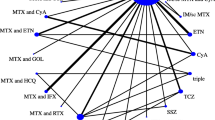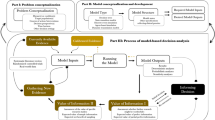Abstract
When competing strategies for development programs, clinical trial designs, or data analysis methods exist, the alternatives need to be evaluated in a systematic way to facilitate informed decision making. Here we describe a refinement of the recently proposed clinical scenario evaluation framework for the assessment of competing strategies. The refinement is achieved by subdividing key elements previously proposed into new categories, distinguishing between quantities that can be estimated from preexisting data and those that cannot and between aspects under the control of the decision maker from those that are determined by external constraints. The refined framework is illustrated by an application to a design project for an adaptive seamless design for a clinical trial in progressive multiple sclerosis.
Similar content being viewed by others
References
Benda N, Branson M, Maurer W, Friede T. Aspects of modernizing drug development using clinical scenario planning and evaluation. Drug Inf J. 2010;44:299–315.
Sheiner LB. Learning versus confirming in clinical drug development. Clin Pharmacol Ther. 1997; 61:275–291.
Todd S, Slallard N. A new clinical trial design combining phases II and III: sequential designs with treatment selection and a change of end-point. Drug Inf J. 2005;39:109–118.
Maca J, Bhattacharya S, Dragalin V, Gallo P, Krams M. Adaptive seamless phase II/III designs: background, operational aspects, and examples. Drug Inf J. 2006;40:463–473.
Bretz. F, Schmidli H, Koenig F, Racine A, Maurer W. Confirmatory seamless phase II/III clinical trials with hypotheses selection at interim: general concepts. Biometric J. 2006;48:623–634.
US Food and Drug Administration. Innovation/stagnation: Critical Path opportunity list. FDA Report, March 2006. http://www.fda.gov/downloads/ScienceResearch/SpcciaITopics/CriticaIPathlnitiative/CriticalPathOpportunitiesReporls/UCM077258.pdf (accessed October 25, 2009).
Committee for Medicinal Products for Human Use. Reflection paper on methodological issues in confirmatory clinical trials planned with an adaptive design. 2007. Doc. Ref. CHMP/EWP/2459/02. www.ema.europa.eu/pdfs/human/ewp/245902en.pdf (accessed February 7, 2010).
Friede T, Stallard N. A comparison of methods for adaptive treatment selection. Biometric J. 2008;50:767–781.
Bretz F, Koenig F, Brannath W, Glimm E, Posch M. Tutorial in biostatistics: adaptive designs for confirmatory clinical trials. Stat Med. 2009; 28:1181–1217.
Quinlan JA. Krams M. Implementing adaptive designs: logistical and operational considerations. Drug Inf J. 2006;40:437–444.
Gallo P. Operational challenges in adaptive design implementation. Pharm Stat. 2006;5:119–124.
Gallo P, Chuang-Stein C. What should be the role of homogeneity testing in adaptive trials? Pharm Stat. 2009;8:1–4.
Committee for Medicinal Products for Human Use. Guideline on clinical investigation of medicinal products for the treatment of multiple sclerosis. 2005. Doc. Ref. CPMP/EWP/561/98Rev 1. www.emea.europa.eu/pdfs/human/ewp/56198en.pdf (accessed February 7, 2010).
Barkhof F. Calabresi PA, Miller DH, Reingold SC. Imaging outcomes for neuroprotection and repair in multiple sclerosis trials. Nat Rev Neurol. 2009;5:256–266.
Molyneux PD, Barker GJ, Barkhof F, el al. for the European Study Group on Interferon Beta-1b in Secondary Progressive MS. Clinical-MRI correlations in a European trial of interferon beta-1b in secondary progressive MS. Neurology. 2001; 57:2191–2197.
Sormani MP, Laura Bonzano L, Roccalagliata L, Culler CR, Mancardi GL, Bruzzi P. Magnetic resonance imaging as a potential surrogate for relapses in multiple sclerosis: a meta-analytic approach. Ann Neurol. 2009;65:268–275.
Chataway J, Nicholas R, Todd S, el al. A novel adaptive design strategy increases the efficiency of clinical trials in secondary progressive multiple sclerosis. Multiple Sclerosis (in press).
Chuang-Stein C, Anderson K, Gallo P, Collins S. Sample size reestimation: a review and recommendations. Drug Inf J. 2006;40:475–484.
Held U, Steyer K, Menzler S, Kuechenhoff H, Daumer M. Evaluation of some alternative designs for phase 2 multiple sclerosis trials: a simulation study. Drug Inf J. 2008;42:359–367.
Benda N, Branson M, Maurer W, Friede T. Clinical Scenario Evaluation—A framework for the evaluation of competing development strategies, Drug Devel. 2009;4:84–88.
Author information
Authors and Affiliations
Corresponding author
Rights and permissions
About this article
Cite this article
Friede, T., Nicholas, R., Stallard, N. et al. Refinement of the Clinical Scenario Evaluation Framework for Assessment of Competing Development Strategies with an Application to Multiple Sclerosis. Ther Innov Regul Sci 44, 713–718 (2010). https://doi.org/10.1177/009286151004400607
Received:
Accepted:
Published:
Issue Date:
DOI: https://doi.org/10.1177/009286151004400607




